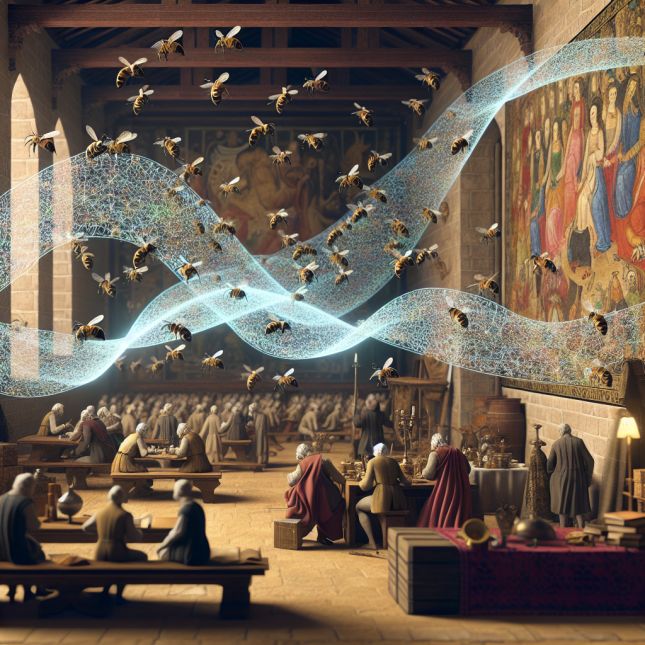Group Mind: Where Bad Ideas Go Viral and Capital Gets Torched
April 15, 2025
Each generation believes uniquely enlightened, yet each succumbs to the same ancient folly—trusting the wisdom of crowds. Crowds, however, possess no wisdom. They merely amplify human irrationality, transforming individual uncertainty into collective delusion. “Group mind,” Carl Jung once warned, “is always inferior to individual consciousness.” Yet investors, politicians, and pundits repeatedly ignore this truth, foolishly embracing consensus until it devours them. Ask silly questions of the herd, and the herd provides stupid answers. Follow those answers into markets, and you win only stupid prizes—loss, ruin, and regret. History repeatedly demonstrates that markets punish conformity mercilessly, rewarding the contrarian who dares to question groupthink instead.
The Illusion of Collective Intelligence: Machiavelli’s Warning
Niccolò Machiavelli, who understood human nature perhaps better than any political theorist before or since, cautioned princes never to trust the fickle passions of crowds. “The vulgar crowd,” he wrote, “is always taken by appearances, and the world consists chiefly of the vulgar.” Yet, centuries later, investors continue making precisely the mistake Machiavelli warned against: believing group consensus reflects deeper wisdom.
Machiavelli recognised that the group mind is but a shadow—an echo chamber reverberating with superficial assumptions, fleeting passions, and transient emotions. Investors who rely on collective intelligence inevitably discover it to be a mirage, vanishing precisely when needed most. Markets repeatedly demonstrate this paradox: as confidence swells, skepticism declines, and the illusion of collective wisdom reaches its peak precisely when it is least justified.
Consider the 2008 financial crisis. Bankers, economists, and regulators—all intelligent individually—collectively embraced the absurd belief that housing prices could never decline nationwide. This groupthink permeated every level of finance, government, and academia. Mesmerized by rising profits and confident consensus, the collective mind failed spectacularly when confronted with reality. Machiavelli would have smiled grimly, recognizing the timeless accuracy of his insight: trusting crowds leads inevitably to ruin.
Sherlock Holmes and the Art of Contrarian Observation
If Machiavelli warned against the herd’s seductive folly, Sherlock Holmes demonstrated how to escape it: through disciplined observation and relentless skepticism. Holmes solved mysteries precisely by ignoring conventional wisdom, focusing instead on subtle details the group mind overlooked or dismissed. “You see,” Holmes observed, “but you do not observe. The distinction is clear.” Investors, similarly, must learn not merely to see market phenomena but to observe them—recognizing underlying patterns rather than superficial narratives.
Technical analysis provides investors with Holmesian tools, enabling them to read market clues objectively rather than succumb to popular interpretations. Price charts serve as crime scenes, offering subtle evidence of collective emotions like fear, greed, complacency, or panic. Volume spikes, moving averages, momentum divergences—each technical indicator whispers clues about the true state of market psychology behind the façade of conventional wisdom.
Consider the dot-com bubble of 1999-2000. While the group mind celebrated endlessly rising technology stocks, technical analysis quietly revealed disturbing divergences: declining breadth, weakening momentum, and deteriorating volume patterns. Investors who observed rather than merely saw—who applied Holmes’s disciplined skepticism rather than groupthink’s blind optimism—recognized these subtle clues and escaped disaster.
Thus, Holmes teaches investors the profound difference between perception and observation. The group mind perceives only superficial narratives; the contrarian investor observes hidden patterns beneath surface stories. Mastering technical analysis transforms investors from passive spectators into active observers, empowering them to circumvent the herd’s seductive illusions.
The Vector of Mass Psychology: Markets as Emotional Ecosystems
The market is not a machine but an emotional ecosystem, driven less by rational calculations than by collective psychological currents. Mass psychology moves markets, creating cycles of optimism, pessimism, euphoria, and despair. Though invisible to casual observers, these emotional tides become starkly visible through technical analysis.
Mass psychology reveals itself through predictable stages: disbelief, optimism, excitement, thrill, euphoria, anxiety, denial, panic, capitulation, despair, and finally, cautious hope. Each stage generates distinct technical patterns. Euphoria manifests as parabolic price accelerations and panic as sharp declines accompanied by massive volume spikes. Recognizing these emotional signatures enables investors to gauge market sentiment objectively rather than relying on subjective impressions or group consensus.
Consider Bitcoin’s meteoric rise and subsequent volatility. Mass psychology drove prices upward initially through optimism, then excitement, thrill, and finally, euphoric mania. Investors who tracked technical indicators like RSI divergence, parabolic price action, and unsustainable momentum gains clearly recognised when sentiment reached dangerous extremes. Conversely, investors trusting group consensus—convinced prices would rise indefinitely—suffered devastating losses when emotional tides inevitably reversed.
Understanding mass psychology as a vector—possessing both direction and magnitude—enables investors to measure market sentiment objectively. Technical analysis provides the compass, indicating precisely when emotional currents have reached unsustainable extremes. Investors who master these tools ride emotional tides profitably rather than drowning beneath them.
The Silly Questions of Pundits, Prophets, and Charlatans
Yet despite abundant evidence of the herd’s irrationality, market pundits continually pose silly questions to the group mind, receiving predictably stupid answers. “Is this the new economy?” they ask, or “Has inflation finally disappeared forever?” or “Is Bitcoin the future of money?” Each generation’s experts, convinced of their uniqueness, ask precisely the same foolish questions, receiving precisely the same misguided answers.
These silly questions reveal humanity’s profound misunderstanding of markets—not rational calculators but emotional ecosystems. Markets care little for narratives of novelty or uniqueness; they respond instead to timeless emotional patterns. Investors who understand this dynamic disregard fashionable questions, focusing instead on emotional indicators revealed through technical analysis.
Consider the repeated question, “Is this time different?” posed during every market bubble—from 1929’s roaring twenties to 1999’s dot-com euphoria to today’s cryptocurrency mania. Each time, the herd confidently answers “yes,” convinced fundamental rules no longer apply. Each time, technical indicators—including momentum divergences, deteriorating breadth, and parabolic price accelerations—clearly reveal emotional excess. Investors trusting technical analysis rather than silly questions escape unscathed; investors trusting the herd suffer predictably painful consequences.
Thus, investors must reject the false wisdom of pundits, prophets, and charlatans who pose silly questions to the group mind. Markets reward not conformity but disciplined contrarianism informed by objective technical analysis.
The Disease of Conformity: Symptoms, Diagnosis, and Cure
Humanity’s conformity disease manifests through predictable symptoms: groupthink, confirmation bias, herd behavior, and irrational exuberance. Individually intelligent investors become collectively irrational, swept along by emotional currents of greed or fear. Diagnosing this conformity disease—recognizing its symptoms objectively through technical analysis—provides investors with powerful immunity.
Technical analysis diagnoses conformity disease clearly. When all investors behave similarly—buying aggressively, celebrating new highs, ignoring risks—technical indicators reveal warning signals clearly: unsustainable price acceleration, extreme overbought readings, declining breadth indicators. Conversely, when conformity disease manifests through collective panic—massive selling, despairing headlines, and extreme oversold conditions—technical indicators signal precisely when emotional currents have become excessively pessimistic.
Consider March 2020’s pandemic crash. Conformity disease manifested through collective panic—investors selling indiscriminately, headlines predicting financial apocalypse. Yet technical analysis clearly indicated sentiment had reached unsustainable extremes: record-high volatility, record-low breadth, extreme oversold momentum readings. Investors diagnosing conformity disease through these indicators recognized the powerful contrarian opportunity the herd had created.
Thus, technical analysis provides investors with tools to objectively diagnose conformity disease and identify precise opportunities created by collective irrationality. Markets reward investors who reject the herd’s emotional contagion and act instead with disciplined contrarianism informed by objective evidence.
Machiavellian Contrarianism: Exploiting the Herd’s Folly
Machiavelli famously advised princes to exploit the herd’s passions rather than succumb to them. Investors, similarly, must learn not merely to reject groupthink but actively exploit it. Markets reward not passive spectatorship but active Machiavellian contrarianism—buying when the group mind panics and selling when the herd celebrates.
Technical analysis provides investors with Machiavellian tools to exploit collective irrationality systematically. Investors who recognize emotional extremes clearly—through indicators like put-call ratios, volatility spikes, and breadth divergences—position themselves strategically opposite the herd precisely when sentiment reaches unsustainable extremes.
Consider Warren Buffett’s famous advice: “Be fearful when others are greedy, and greedy when others are fearful.” This statement encapsulates Machiavellian contrarianism perfectly. Investors must not merely reject the herd’s passions but actively exploit them—buying when collective fear reaches maximum intensity, selling when collective greed peaks.
Thus, technical analysis transforms investors into Machiavellian contrarians, empowering them to exploit group mind folly systematically rather than suffer beneath it. Markets reward precisely such disciplined exploitation of collective irrationality.
Closing the Circle: Escaping Group Mind’s Eternal Recurrence
Yet, despite abundant evidence, humanity repeatedly and willingly surrenders itself to the group mind’s irrational embrace. Investors continue asking silly questions, receiving stupid answers, and winning predictably stupid prizes. The group mind’s eternal recurrence persists precisely because conformity’s seductive comfort outweighs skepticism’s uncomfortable discipline.
Only investors willing to embrace Machiavellian contrarianism—actively exploiting rather than passively resisting collective irrationality—escape this endless cycle. Technical analysis provides such investors with objective tools to diagnose conformity disease, recognize emotional extremes clearly, and position themselves strategically opposite the herd precisely when sentiment reaches unsustainable levels.
Thus, markets reward neither passive conformity nor skepticism but active Machiavellian contrarianism informed by disciplined observation. Investors who master this approach escape the group mind’s eternal recurrence, transforming collective irrationality from an existential threat into a strategic opportunity.
In the end, humanity’s conformity disease persists eternally. Yet individual investors possess the power to immunize themselves systematically—rejecting silly questions, ignoring stupid answers, and refusing stupid prizes. Markets reward precisely such disciplined contrarianism, punishing instead those who trust blindly in the group mind’s seductive illusion. Machiavelli and Sherlock Holmes, united across centuries in skeptical observation, provide investors with timeless wisdom: trust not the herd, for conformity leads inevitably to ruin.













